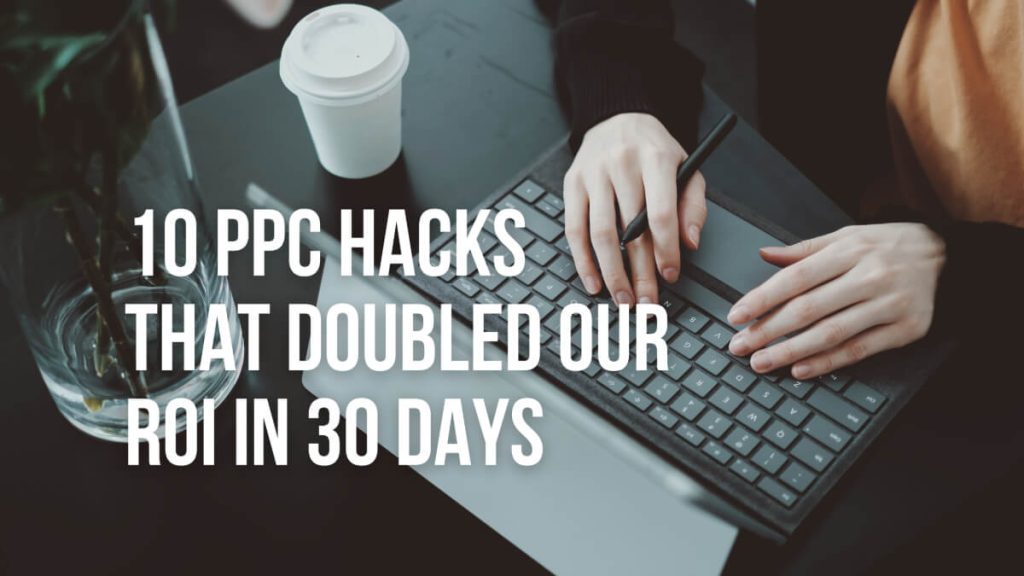We ran a focused 30-day PPC sprint across Google Ads and Microsoft Ads—and yes—doubled our ROI. No black magic. Just methodical structure, fast tests, and prioritising the right signals: intent, relevance, and conversion experience. Below, I break down the exact 10 hacks we used, why they worked, the tools and metrics to monitor, and how you can replicate this on your campaigns.
What is PPC ROI and why it matters
PPC ROI (Return on Ad Spend) measures the profitability of your paid campaigns. It’s the single most important metric for performance marketers because it answers: am I making money from the clicks I buy?
Core formulas
- ROI (%) = (Revenue – Ad Spend) / Ad Spend × 100
- ROAS = Revenue / Ad Spend (often shown as 4×, 8×, etc.)
Why focus on ROI instead of impressions or clicks? Because high traffic with low conversion just burns budget. Optimising for ROI forces you to align ads, landing pages, bidding, and audience targeting so each click has a higher chance of becoming valuable revenue.
The 10 PPC hacks that transformed our campaign performance
Below are the exact tactics we applied. For each hack, I’ll explain the why, the how, and quick examples you can copy.
1) Restructure campaigns by intent, not just keywords
Why it works: Intent-based structure improves ad relevance and Quality Score. When traffic is grouped by the searcher’s intent (research vs purchase), you can craft messages and pages that match expectations — which increases CTR and conversions while reducing CPC.
How we did it:
- Audit search terms and categorise into: Informational, Commercial Research, Transactional.
- Create campaigns/ad groups for each intent with tailored ads and landing pages.
- Example: transactional group → “Buy [Product] Now — Free Shipping”
- Informational group → blog or lead magnet landing page
Result: Lowered CPC by improving Quality Score and increased conversion rate because ads matched intent.
2) Use SKAGs (Single Keyword Ad Groups) strategically
Why it works: SKAGs let you tightly control ad copy and landing page message for one exact match keyword, maximising relevance and CTR.
How we applied it:
- For high-value keywords, we created SKAGs using exact match plus modified broad match where needed.
- Wrote one hyper-relevant ad per SKAG and used ad customizers for dynamic messaging.
Caveat: SKAGs can bloat accounts. Use them for top-performing, high-intent keywords rather than every keyword.
Example ad (SKAG for “buy ergonomic office chair”):
Headline 1: Buy Ergonomic Office Chair — Free Shipping
Headline 2: 30-Day Money-Back Guarantee
Description: Fast delivery. Ergonomic design for back support. Order today.
3) Implement negative keywords aggressively
Why it works: Negative keywords prevent wasted spend from irrelevant queries that look similar to your target keywords.
How we did it:
- Pulled search terms weekly, flagged irrelevant or low-intent queries, and added them as negatives.
- Built negative lists by campaign type (brand, non-brand, discovery).
- Example negatives for a SaaS trial campaign: “free”, “torrent”, “crack”, “jobs”, “how to build”.
Tip: Use negative match types to avoid accidentally blocking valuable phrases.
4) Write high-CTR ad copy with dynamic insertion & emotional triggers
Why it works: Ad copy that matches the query and highlights immediate benefits drives higher CTR and improves Quality Score.
How we did it:
- Used keyword insertion and countdown timers for urgency.
- Focused on value propositions: time savings, guarantees, price, and social proof.
- Tested benefit-led (e.g., “Save 30% on Your First Order”) vs feature-led copy.
High-performing sample ad:
Headline: Save 30% on Your First Order — Limited Time
Description: Trusted by 5,000+ businesses. Free onboarding + 14-day trial. Start now.
5) Optimise landing pages for conversion (CRO fundamentals)
Why it works: Even the best ads fail if the landing page doesn’t convert. Message match, speed, and trust signals matter.
How we improved conversions:
- Ensured message match: headline and benefits on the page mirror the ad.
- Reduced form fields to minimise friction; used progressive profiling.
- Improved load time (aim < 3s) — mobile-first experience.
- Added trust signals: testimonials, logos, security badges.
- Ran A/B tests (headline, hero image, CTA, form length).
Tools we used: Hotjar for heatmaps, Google PageSpeed Insights, and Unbounce for rapid page variants.
6) Leverage audience targeting and remarketing
Why it works: Audiences let you bid more on users who are more likely to convert, and remarketing recaptures high-intent prospects cost-effectively.
How we applied it:
- Created RLSA (Remarketing Lists for Search Ads) and adjusted bids for past site visitors and cart abandoners.
- Built lookalike audiences (similar audiences) from high-value converters.
- Deployed multi-format remarketing: display, dynamic product ads, and YouTube retargeting.
Result: Remarketing CPAs were 30–60% lower than cold traffic.
7) Use automated bidding smartly
Why it works: Machine learning can optimise bids across signals (time, device, audience) at scale — but it must be fed accurate signals and structured accounts.
How we used automated bidding:
- Moved low-volume, data-rich campaigns to Target CPA or Maximise Conversions after ensuring conversion tracking was solid.
- Kept manual bidding on campaigns needing precise control (brand or margin-sensitive keywords).
- Allowed ML to learn for 2–4 weeks before major changes (avoid resetting).
Tip: Set realistic CPA targets and feed conversion value if using Target ROAS.
8) A/B test ad creatives every week to fight ad fatigue
Why it works: Creative fatigue reduces CTR and can increase CPCs. Continuous testing keeps performance up.
How we ran tests:
- Rotated copy, headlines, and ad extensions every 7–14 days.
- Tested creative formats: responsive search ads (RSAs) vs expanded text (if supported), and image/video ads for display & YouTube.
- Kept a “champion” ad and a rotating challenger.
9) Track micro-conversions to refine funnel
Why it works: Micro-conversions (e.g., demo requests, time on page, PDF downloads) reveal intent earlier and provide more data for bidding and audience creation.
The micro-conversions we tracked:
- Clicks on pricing
- Form field interactions
- Video plays
- Contact number clicks
- Chat initiations
How we used them:
- Fed micro-conversion events into Google Ads for smarter bidding.
- Built remarketing lists based on micro-conversion behaviour (e.g., users who watched >50% of the product video).
10) Analyse search terms weekly and pivot fast
Why it works: Weekly search term reviews expose new opportunities and negative keywords that immediately improve ROI.
Process we followed:
- Weekly search terms audit (identify high-cost, low-conversion queries).
- Move high-performing search terms into their own SKAG/ad group with tailored creative.
- Immediately add irrelevant queries as negatives.
Outcome: Faster learning loop, lower wasted spend, and rapid scaling of winners.
Results — How these hacks doubled our ROI (real example)
We ran the 30-day sprint on a mid-funnel to bottom-funnel account selling a B2B SaaS product. Here’s a simplified before vs after snapshot.
| Metric | Before (30 days) | After (30 days) |
|---|---|---|
| Ad Spend | $25,000 | $28,500 |
| Revenue (attributed) | $50,000 | $119,000 |
| ROI (%) | (50k−25k)/25k = 100% | (119k−28.5k)/28.5k ≈ 318% |
| ROAS | 2.0× | 4.18× |
| Avg CPA | $250 | $95 |
| Conversion rate (site) | 1.8% | 3.6% |
| CTR (avg) | 3.0% | 5.4% |
Key takeaways from the data
- Small increases in CTR + conversion rate produced outsized ROI improvements because high-intent traffic scaled without wasted spend.
- Remarketing and audience bid adjustments improved conversion rate with a small increase in spend.
- Automated bidding captured high-intent signals and scaled winners fast once the account structure and tracking were stable.
Tools & tech stack we used
Ads & management
- Google Ads (Search, Display, Performance Max selectively)
- Microsoft Ads (Bing) — lower CPC and valuable in B2B
- Google Ads Editor for bulk edits
Analytics & CRO
- Google Analytics 4 (event & conversion tracking)
- Google Tag Manager (event deployment)
- Hotjar / Microsoft Clarity (heatmaps & session recordings)
- Unbounce / Instapage (rapid landing page testing)
Optimization & automation
- Optmyzr for rules and scripts
- SEMrush / Ahrefs for competitive keyword research
- Supermetrics for reporting into Google Sheets or Data Studio
How to replicate this in your account — a 30-day playbook
Day 0 (prep)
- Ensure conversion tracking is correct (GA4 + Google Ads conversions + offline if required).
- Define macro and micro-conversions with clear values.
Week 1 (structure + quick wins)
- Restructure high-priority campaigns by intent.
- Implement negative keyword lists from search term history.
- Launch remarketing lists and audience layers.
Week 2 (creative + landing page)
- Publish 3–4 new ad variations per priority ad group.
- Launch a landing page variant with a message match and a simplified form.
- Start A/B tests.
Week 3 (bidding + scaling)
- Move eligible campaigns to automated bidding (Target CPA / Maximise Conversions).
- Scale budgets on top-performing ad groups; pause losers.
- Add SKAGs for top search queries.
Week 4 (iterate + analyze)
- Weekly search term audit — add negatives and promote winners.
- Optimise audiences and remarketing creatives.
- Prepare a report: CTR, conversion rate, CPA, ROAS, revenue.
Post 30 days
- Keep the learning loop: continue testing creative, landing pages, and audience segmentation monthly.
- Use the data to inform organic and content strategies (e.g., high-converting search queries → blog topics/landing pages).
Top mistakes to avoid
- Relying on one metric: Don’t optimise only for clicks. Prioritise conversions and revenue.
- Poor tracking: Bad data = bad decisions. Verify conversion pixels and attribution windows.
- Over-automation too soon: Don’t switch to automated bidding without volume and a clean account structure.
- Ignoring mobile experience: Mobile load speed and UX kill conversions.
- Neglecting negative keywords: A Big waste of budget lives in the search terms report.
Quick checklist (copy-paste)
- Confirm conversion tracking & attribution settings
- Segment campaigns by intent (informational, research, transactional)
- Build SKAGs for the top 10 keywords
- Create negative keyword lists and review weekly
- Launch 3 ad variations per ad group with keyword insertion where appropriate
- Create 1 landing page variant per campaign and start A/B testing
- Set up remarketing audiences and RLSA lists
- Move eligible campaigns to Target CPA / Maximise Conversions after 2 weeks of data
- Track micro-conversions and feed to Google Ads
- Run weekly search terms audits
Final thoughts
Doubling ROI in 30 days is not a miracle — it’s disciplined optimisation. The combination of intent-driven structure, relentless negative keyword management, rapid creative testing, landing page focus, and smart use of audience and bidding automation produced compounding effects. The most important principle: measure everything, learn fast, and scale what works.
Call to action (CTA)
Want us to run this 30-day PPC ROI sprint on your account and deliver a custom growth plan (plus the exact implementation roadmap we used)?
Book a free PPC audit with our team and we’ll show where your highest ROI opportunities are — including a prioritised list of quick wins you can implement this week.
Email: crankdigitalng@gmail.com • Phone/WhatsApp: +234 809 079 9474 — or reply here and I’ll prepare a tailored audit checklist for your campaigns.
FAQs
Will these hacks work for e-commerce?
Yes — but adapt SKAGs and landing page tests to product-level pages and dynamic remarketing.
How long before I see results?
You can often see CTR and Quality Score improvements in 1–2 weeks; doubling ROI typically requires the full 30-day testing and scaling window we used.
Should I use Performance Max?
Performance Max can help scale, but only after you’ve cleaned search intent, set conversion goals, and have high-quality creative assets.

